Top 10
The First Bakers
By ERIC A. POWELL
Monday, December 10, 2018
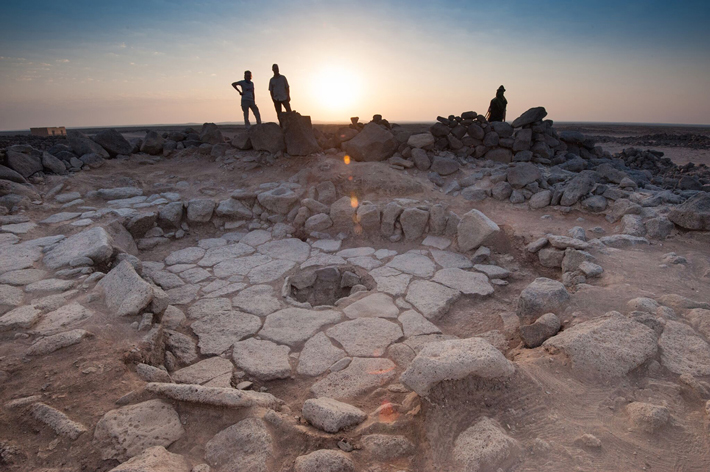 About 14,400 years ago in the Black Desert of northeastern Jordan, someone was tinkering with the recipe for the perfect pita. This auspicious moment in culinary history has been captured by researchers who sampled the contents of two stone fireplaces at the site of Shubayqa 1. The team, led by University of Copenhagen archaeobotanist Amaia Arranz-Otaegui, found that the people living at this small campsite, hunter-gatherers who belonged to a culture known as the Natufians, were making unleavened bread-like products at least 4,000 years before the dawn of agriculture. Charred remains from the ovens suggest Natufians gathered wild cereals and tubers to make flour for the bread, which, at the time, was probably not a staple food, but a rare treat reserved for special occasions. “We were very surprised to find bread made before the origins of agriculture,” says Arranz-Otaegui. “Archaeologists have tended to ignore food remains that we don’t recognize, and I’m sure the remains of bread-like products even more ancient than these are everywhere.”
About 14,400 years ago in the Black Desert of northeastern Jordan, someone was tinkering with the recipe for the perfect pita. This auspicious moment in culinary history has been captured by researchers who sampled the contents of two stone fireplaces at the site of Shubayqa 1. The team, led by University of Copenhagen archaeobotanist Amaia Arranz-Otaegui, found that the people living at this small campsite, hunter-gatherers who belonged to a culture known as the Natufians, were making unleavened bread-like products at least 4,000 years before the dawn of agriculture. Charred remains from the ovens suggest Natufians gathered wild cereals and tubers to make flour for the bread, which, at the time, was probably not a staple food, but a rare treat reserved for special occasions. “We were very surprised to find bread made before the origins of agriculture,” says Arranz-Otaegui. “Archaeologists have tended to ignore food remains that we don’t recognize, and I’m sure the remains of bread-like products even more ancient than these are everywhere.”
Meanwhile, a Stanford University team analyzed residues on three Natufian stone mortars unearthed roughly 150 miles west of Shubayqa 1, in Israel’s Raqefet Cave. They detected evidence that Natufians were brewing beer from wild wheat and barley 13,000 years ago, well before those grains were domesticated. The two discoveries suggest that our prehistoric ancestors were bakers and brewers thousands of years before they even contemplated becoming full-time farmers.
Oldest Sketch
By MARLEY BROWN
Monday, December 10, 2018
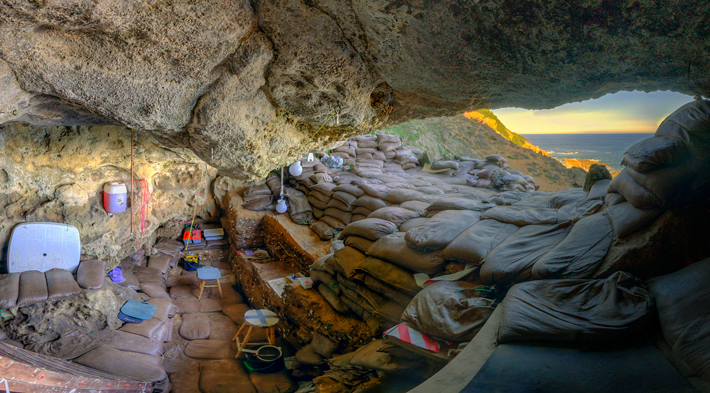
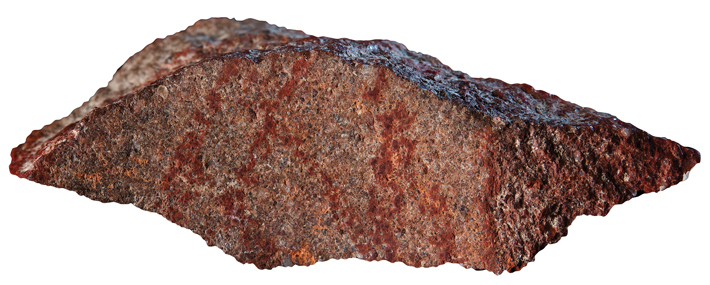 The world’s oldest known drawing has been identified on a small stone flake recovered in South Africa’s Blombos Cave. The tiny fragment measures less than two inches long and barely half an inch wide and features a crosshatch pattern of visible lines. A research team first used microscopic and chemical analysis to determine that the marks are composed of ochre pigment lying on the flake’s surface. They then attempted to replicate the pattern using pieces of ochre. Doing so required a firm hand and controlled motions, explains Christopher Henshilwood of the University of Bergen. This led his team to conclude that a human deliberately applied them with an ochre crayon around 73,000 years ago. “The design almost certainly had some meaning to the maker,” Henshilwood says. “It probably formed part of a common symbolic system understood by other people in their group.
The world’s oldest known drawing has been identified on a small stone flake recovered in South Africa’s Blombos Cave. The tiny fragment measures less than two inches long and barely half an inch wide and features a crosshatch pattern of visible lines. A research team first used microscopic and chemical analysis to determine that the marks are composed of ochre pigment lying on the flake’s surface. They then attempted to replicate the pattern using pieces of ochre. Doing so required a firm hand and controlled motions, explains Christopher Henshilwood of the University of Bergen. This led his team to conclude that a human deliberately applied them with an ochre crayon around 73,000 years ago. “The design almost certainly had some meaning to the maker,” Henshilwood says. “It probably formed part of a common symbolic system understood by other people in their group.
Bronze Age Plague
By DANIEL WEISS
Monday, December 10, 2018
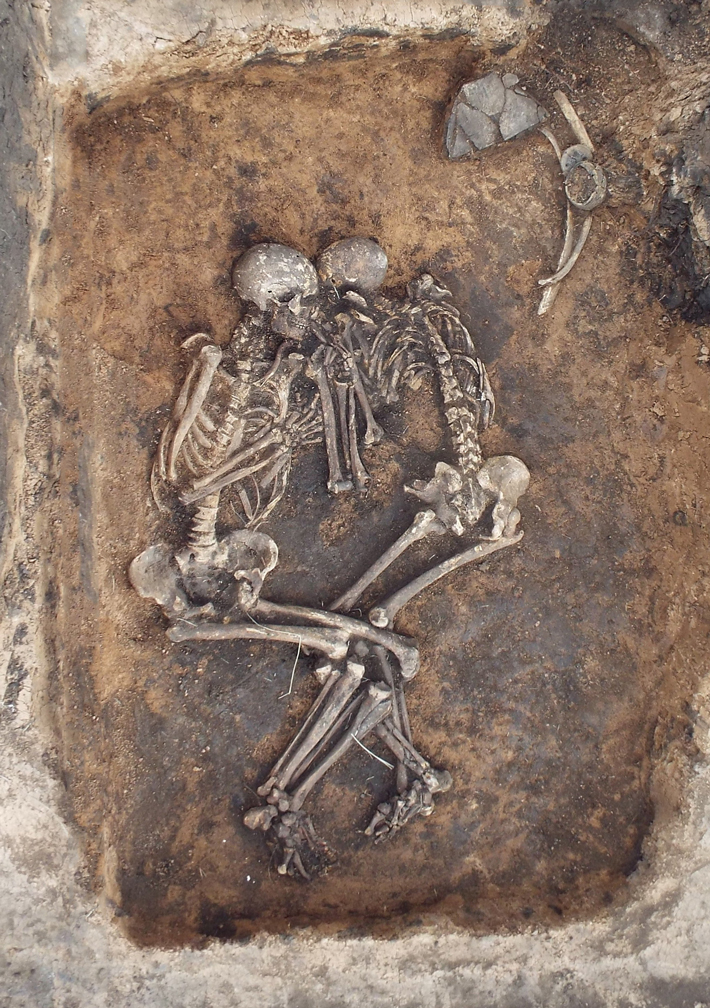 The bacterium that causes bubonic plague, Yersinia pestis, has been responsible for some of the most devastating pandemics in history, including the Black Death, which killed more than half of Europe’s population in the fourteenth century. The first recorded outbreak was the sixth-century A.D. Justinian Plague, but researchers have now found evidence that a virulent form of the bacterium was circulating at least as early as 1800 B.C.
The bacterium that causes bubonic plague, Yersinia pestis, has been responsible for some of the most devastating pandemics in history, including the Black Death, which killed more than half of Europe’s population in the fourteenth century. The first recorded outbreak was the sixth-century A.D. Justinian Plague, but researchers have now found evidence that a virulent form of the bacterium was circulating at least as early as 1800 B.C.
The team sequenced the genomes of Y. pestis recovered from two Bronze Age skeletons—one male and one female—buried together in southwestern Russia. They determined that the strain with which the pair was infected had developed mutations that allowed it to be carried by fleas. Researchers are unsure how earlier known strains of the bacterium were spread, but they are certain that fleas spread plague efficiently, allowing it to reach pandemic levels. “We know of a lot of historical outbreaks of disease for which the causes have not yet been identified,” says Maria Spyrou of the Max Planck Institute for the Science of Human History. “Now that we know that Y. pestis has been capable of causing epidemics in humans for the past 4,000 years, we have to start screening more material to determine whether it could have been involved.” The team hopes to find evidence of early plague outbreaks that have gone unrecorded.
An Eccentric Artifact
By DANIEL WEISS
Monday, December 10, 2018
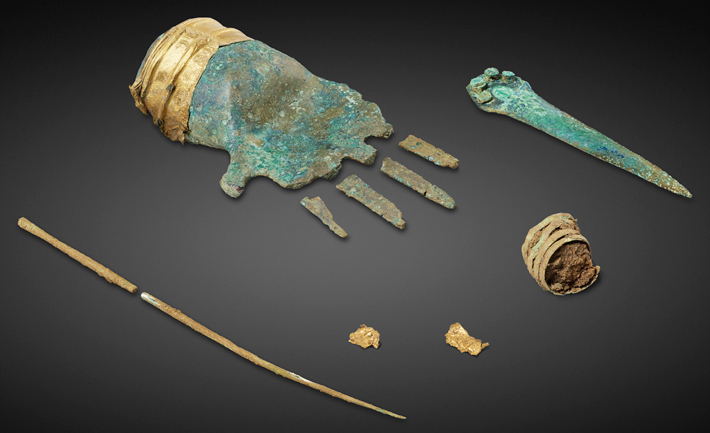 Swiss archaeologists were baffled when they first saw the bronze hand wearing a gold foil bracelet. All the evidence—including radiocarbon dating of vegetable glue used to affix the gold foil and the style of a bronze dagger found along with the hand—suggests the unusual artifact was fashioned in the mid-second millennium B.C. But nothing like it is known from the period.
Swiss archaeologists were baffled when they first saw the bronze hand wearing a gold foil bracelet. All the evidence—including radiocarbon dating of vegetable glue used to affix the gold foil and the style of a bronze dagger found along with the hand—suggests the unusual artifact was fashioned in the mid-second millennium B.C. But nothing like it is known from the period.
At the site where the hand was found—a spectacular plateau in the shadow of the Alps and the Jura Mountains—archaeologists unearthed a man’s skeleton, along with a missing finger from the bronze hand as well as a bronze pin and spiral and several gold flakes. The hand’s purpose is enigmatic. “It may have been this man’s insignia,” says Andrea Schaer of the Archaeological Service of the Canton of Bern, “and when he died it was buried with him.” She says the hand also may have served as a symbolic replacement for one perhaps lost by the man during his life, though it is too delicate to have been a practical prosthetic.
Early Americans
By LYDIA PYNE
Monday, December 10, 2018
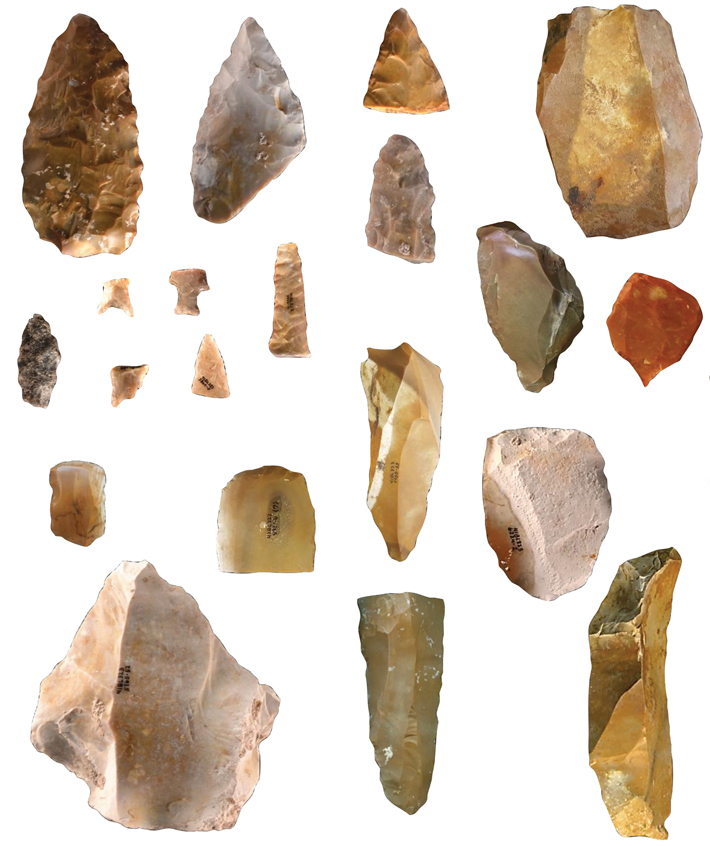 One of the most intriguing questions in American archaeology is, Who were the earliest people in the Americas? For much of the past 80 years, scholars have thought that they were members of the Clovis culture, whose ancestors came to North America from Siberia some 13,000 years ago. In recent decades, however, archaeologists have come to believe that people reached North America far earlier. A new discovery from the Gault site, in central Texas, offers robust evidence not only for a much earlier peopling of the Americas, but also of a previously unknown tool tradition that is older and more varied than scholars ever expected.
One of the most intriguing questions in American archaeology is, Who were the earliest people in the Americas? For much of the past 80 years, scholars have thought that they were members of the Clovis culture, whose ancestors came to North America from Siberia some 13,000 years ago. In recent decades, however, archaeologists have come to believe that people reached North America far earlier. A new discovery from the Gault site, in central Texas, offers robust evidence not only for a much earlier peopling of the Americas, but also of a previously unknown tool tradition that is older and more varied than scholars ever expected.
Archaeologists have found stone tools including projectile points, blades, and flake tools at the Gault site, the oldest of which date to between 20,000 and 16,000 years ago, thousands of years older than any of the fluted stone spear points for which the Clovis are known. “What we’re seeing is a well-developed toolkit,” says Tom Williams of Texas State University. “These were clearly people adapted to surviving in their environment.”
Advertisement
Advertisement
IN THIS ISSUE
Advertisement

Recent Issues
-
 May/June 2024
May/June 2024
-
 March/April 2024
March/April 2024
-
 January/February 2024
January/February 2024
-
 November/December 2023
November/December 2023
-
 September/October 2023
September/October 2023
-
 July/August 2023
July/August 2023
-
 May/June 2023
May/June 2023
-
 March/April 2023
March/April 2023
-
 January/February 2023
January/February 2023
-
 November/December 2022
November/December 2022
-
 September/October 2022
September/October 2022
-
 July/August 2022
July/August 2022
-
 May/June 2022
May/June 2022
-
 March/April 2022
March/April 2022
-
 January/February 2022
January/February 2022
-
 November/December 2021
November/December 2021
-
 September/October 2021
September/October 2021
-
 July/August 2021
July/August 2021
-
 May/June 2021
May/June 2021
-
 March/April 2021
March/April 2021
-
 January/February 2021
January/February 2021
-
 November/December 2020
November/December 2020
-
 September/October 2020
September/October 2020
-
 July/August 2020
July/August 2020
-
 May/June 2020
May/June 2020
-
 March/April 2020
March/April 2020
-
 January/February 2020
January/February 2020
-
 November/December 2019
November/December 2019
-
 September/October 2019
September/October 2019
-
 July/August 2019
July/August 2019
-
 May/June 2019
May/June 2019
-
 March/April 2019
March/April 2019
-
 January/February 2019
January/February 2019
-
 November/December 2018
November/December 2018
-
 September/October 2018
September/October 2018
-
 July/August 2018
July/August 2018
-
 May/June 2018
May/June 2018
-
 March/April 2018
March/April 2018
-
 January/February 2018
January/February 2018
-
 November/December 2017
November/December 2017
-
 September/October 2017
September/October 2017
-
 July/August 2017
July/August 2017
-
 May/June 2017
May/June 2017
-
 March/April 2017
March/April 2017
-
 January/February 2017
January/February 2017
-
 November/December 2016
November/December 2016
-
 September/October 2016
September/October 2016
-
 July/August 2016
July/August 2016
-
 May/June 2016
May/June 2016
-
 March/April 2016
March/April 2016
-
 January/February 2016
January/February 2016
-
 November/December 2015
November/December 2015
-
 September/October 2015
September/October 2015
-
 July/August 2015
July/August 2015
-
 May/June 2015
May/June 2015
-
 March/April 2015
March/April 2015
-
 January/February 2015
January/February 2015
-
 November/December 2014
November/December 2014
-
 September/October 2014
September/October 2014
-
 July/August 2014
July/August 2014
-
 May/June 2014
May/June 2014
-
 March/April 2014
March/April 2014
-
 January/February 2014
January/February 2014
-
 November/December 2013
November/December 2013
-
 September/October 2013
September/October 2013
-
 July/August 2013
July/August 2013
-
 May/June 2013
May/June 2013
-
 March/April 2013
March/April 2013
-
 January/February 2013
January/February 2013
-
 November/December 2012
November/December 2012
-
 September/October 2012
September/October 2012
-
 July/August 2012
July/August 2012
-
 May/June 2012
May/June 2012
-
 March/April 2012
March/April 2012
-
 January/February 2012
January/February 2012
-
 November/December 2011
November/December 2011
-
 September/October 2011
September/October 2011
-
 July/August 2011
July/August 2011
-
 May/June 2011
May/June 2011
-
 March/April 2011
March/April 2011
-
 January/February 2011
January/February 2011
Advertisement






